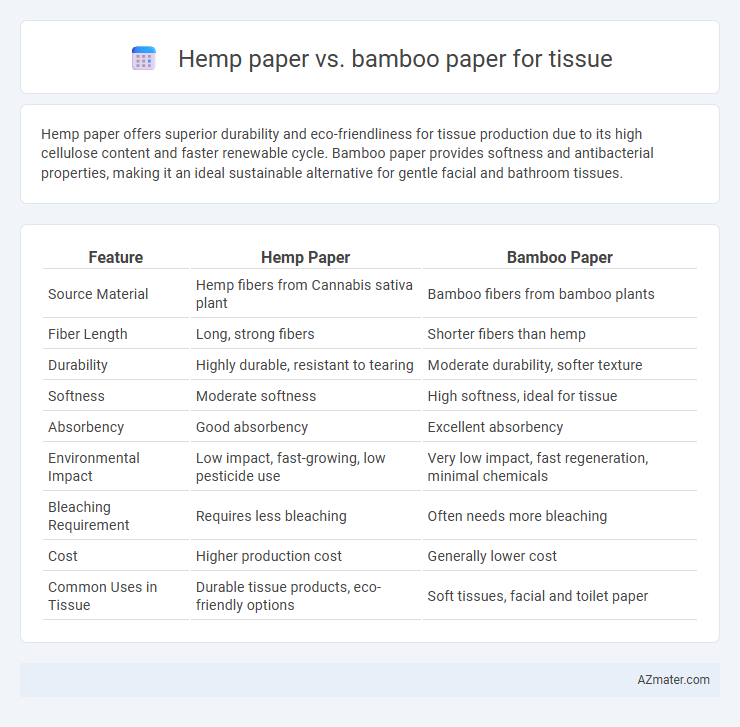Hemp paper offers superior durability and eco-friendliness for tissue production due to its high cellulose content and faster renewable cycle. Bamboo paper provides softness and antibacterial properties, making it an ideal sustainable alternative for gentle facial and bathroom tissues.
Table of Comparison
| Feature | Hemp Paper | Bamboo Paper |
|---|---|---|
| Source Material | Hemp fibers from Cannabis sativa plant | Bamboo fibers from bamboo plants |
| Fiber Length | Long, strong fibers | Shorter fibers than hemp |
| Durability | Highly durable, resistant to tearing | Moderate durability, softer texture |
| Softness | Moderate softness | High softness, ideal for tissue |
| Absorbency | Good absorbency | Excellent absorbency |
| Environmental Impact | Low impact, fast-growing, low pesticide use | Very low impact, fast regeneration, minimal chemicals |
| Bleaching Requirement | Requires less bleaching | Often needs more bleaching |
| Cost | Higher production cost | Generally lower cost |
| Common Uses in Tissue | Durable tissue products, eco-friendly options | Soft tissues, facial and toilet paper |
Introduction: Hemp Paper vs Bamboo Paper for Tissue
Hemp paper offers exceptional strength, durability, and eco-friendly benefits due to its fast-growing and renewable nature, making it an ideal choice for sustainable tissue production. Bamboo paper provides softness and natural antibacterial properties, coupled with rapid growth rates and minimal pesticide use, which supports environmentally responsible manufacturing. Both hemp and bamboo tissue papers rival traditional wood pulp in sustainability, but hemp excels in tensile strength while bamboo outperforms in softness and absorbency.
Environmental Impact of Hemp vs Bamboo Paper
Hemp paper has a significantly lower environmental impact than bamboo paper due to its faster growth rate, requiring less water and pesticides while absorbing more CO2 per acre. Bamboo paper production often involves chemical-intensive processing that can release pollutants, whereas hemp fibers are more easily processed using eco-friendly methods. Overall, hemp's regenerative farming practices contribute to improved soil health and carbon sequestration, making it a more sustainable choice for tissue products.
Raw Material Sustainability: Hemp vs Bamboo
Hemp paper for tissue uses fibers from the Cannabis sativa plant, known for its rapid growth and minimal pesticide requirements, making it a highly sustainable raw material. Bamboo paper is derived from bamboo grass, which also grows quickly and regenerates without replanting, providing a renewable resource with low environmental impact. Compared to traditional wood pulp, both hemp and bamboo offer superior sustainability, but hemp's higher fiber yield per acre and lower water usage often provide a more eco-efficient choice for tissue production.
Production Process: Comparing Hemp and Bamboo Tissues
Hemp tissue production involves harvesting mature hemp stalks, decortication to separate fibers, and chemical or mechanical pulping to create soft, durable paper. Bamboo tissue manufacturing uses fast-growing bamboo culms, subjected to similar pulping processes but requires careful treatment to remove lignin and silica for smooth texture. Both plants undergo bleaching and refining to produce hypoallergenic, biodegradable tissues with Hemp fibers typically offering higher strength and longer fiber length than Bamboo.
Strength and Durability: Hemp-Based vs Bamboo-Based Tissue
Hemp-based tissue exhibits superior strength and durability due to the long, strong fibers of the hemp plant, resulting in less tearing and increased absorbency compared to bamboo-based tissue. Bamboo paper, while eco-friendly and soft, tends to have shorter fibers that can compromise tensile strength and durability under heavy use. The natural lignin content in hemp fibers also enhances the tissue's resilience, making hemp-based products ideal for robust and sustainable tissue applications.
Softness and Comfort: User Experience Analysis
Hemp paper offers a naturally soft texture due to its long fibers, resulting in enhanced comfort and reduced irritation for sensitive skin compared to bamboo paper. Bamboo paper, while sustainable and strong, tends to have a slightly rougher feel, which may affect user experience in terms of softness and comfort. Consumer feedback highlights hemp tissue's superior cushioning quality, making it a preferred choice for those prioritizing gentle skin contact.
Biodegradability and Compostability
Hemp paper offers superior biodegradability and compostability compared to bamboo paper due to its naturally high cellulose content and minimal chemical processing. The rapid decomposition of hemp fibers in soil supports eco-friendly waste management and reduces landfill impact. Bamboo paper, while biodegradable, often undergoes more intensive treatments that can slow composting, making hemp paper a more sustainable choice for tissue products.
Cost and Market Availability
Hemp paper for tissue is typically more expensive due to higher cultivation and processing costs, with limited large-scale market availability compared to bamboo paper, which benefits from faster growth cycles and widespread farming, making it more cost-effective and readily available. Bamboo paper's cost advantage and strong market presence stem from efficient supply chains and greater yields per acre, leading to broader adoption in commercial tissue products. Consumers and manufacturers often choose bamboo tissue for affordability and accessibility, while hemp remains a niche, premium option in sustainable paper markets.
Health Considerations for Sensitive Skin
Hemp paper for tissue is highly regarded for its hypoallergenic properties, making it ideal for sensitive skin due to its natural antimicrobial agents and minimal chemical processing. Bamboo paper also offers softness and strength but may involve more chemical treatments that could irritate sensitive skin. Choosing hemp-based tissue can reduce the risk of allergic reactions and promote better skin health for those prone to irritation.
Future Trends in Sustainable Tissue Alternatives
Hemp paper offers a renewable, fast-growing crop with high cellulose content, making it a strong sustainable tissue alternative. Bamboo paper provides rapid regeneration and antimicrobial properties, appealing to eco-conscious consumers. Future trends emphasize integrating both hemp and bamboo fibers to optimize biodegradability, reduce water usage, and lower carbon footprints in tissue production.

Infographic: Hemp paper vs Bamboo paper for Tissue
 azmater.com
azmater.com